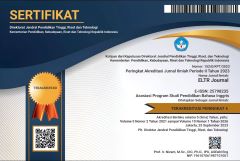THE PRAGMATIC ANALYSIS OF EXCLAMATORY AND EXPRESSIVE UTTERANCES IN LION KING MOVIE (1994)
Abstrak terlihat: 541 / PDF terunduh: 601DOI:
https://doi.org/10.37147/eltr.v2i2.100Keywords:
pragmatics, exclamatory utterance, expressive utterance, Lion King movieAbstract
Communication is very important to our life. It is a kind of media that used to express our intentions, ideas, feelings or information to the listeners or audiences. One of important aspects in the communication is speech acts. Speech acts consist of many categories; one of them is exclamatory and expressive utterances. This study aims to identify exclamatory and expressive utterances performed in the Lion King movie (1994). Likewise, it will find out the type of exclamatory and expressive utterances that are most frequently used in the movie and the other expressive utterances that are found. This study used the qualitative method, reading the transcript, watching the movie and library research. The study also revealed the importance of learning types of utterances in and unique utterances that. This study is expected to give some useful insights into understanding what exclamatory and expressive utterances are.
Downloads
References
Aleksandrzak, M. (2011). Problems and challenges in teaching and learning speaking at advanced level. Glottodidactica, 37, 37-48.
Bach, K. (1997). The semantics-pragmatics distinction: What it is and why it matters. In Pragmatik (pp. 33-50). VS Verlag für Sozialwissenschaften, Wiesbaden.
Beijer, F. (2002). The syntax and pragmatics of exclamations and other expressive/emotional utterances. Working Papers in Linguistics, 2.
Dynel, M. (2011). Stranger than fiction? A few methodological notes on linguistic research in film discourse. Brno Studies in English, 37(1).
Fitria, T. N. (2015). Analysis of Speech Act in Doraemon “Stand by Me” Movie (Doctoral Dissertation, Muhammadiyah University of Surakarta).
Garcia, P. (2004). Pragmatic comprehension of high and low-level language learners. Tesl-Ej, 8(2), n2.
Glanzberg, M. (2005). Focus: A case study on the semantics-pragmatics boundary. Semantics versus pragmatics, 72-110.
Janney, R. (2012). Pragmatics and cinematic discourse. Lodz Papers in Pragmatics, 8(1), 85-113.
Jary, M. & Kissine, M. (2016). When terminology matters: The imperative as a comparative concept. Linguistics, 54(1), 119-148.
Kaburise, P. K. (2004). Speech Act theory and communication: A UNIVEN study (Doctoral dissertation, University of Pretoria).
King, J. & Stanley, J. (2005). Semantics, pragmatics, and the role of semantic content. Semantics versus pragmatics, 111-164.
Kurniasari, P. (2014). The differences between Anna’s and Elsa’s characters based on their Speech Acts in Frozen movie. Yogyakarta: State Islamic University Sunan Kalijaga.
Levinson, S. C. (2017). Speech acts. In Oxford Handbook of Pragmatics (pp. 199-216). Oxford University Press.
Li, D. (2008). The pragmatic construction of word meaning in utterances. Journal of Chinese Language and Computing, 18(3), 121-137.
Lu, L. Y. (2014). Pragmatics and Semiotics: Movies as aesthetic audio-visual device expedite Second Language Acquisition. International Association for Development of the Information Society.
McDonough, J. & McDonough, S. (2014). Research methods for English language teachers. Routledge.
Muhartoyo, M. & Kristani, K. (2013). Directive Speech Act in the movie “Sleeping Beauty”. Humaniora, 4(2), 949-966.
Muthohar, E. F. (2012). An analysis of Speech Act in Changeling movie script (Doctoral dissertation, Universitas Muria Kudus).
Morón, R. G., Cruz, M. P., Amaya, L. F., & López, M. D. L. O. H. (Eds.). (2009). Pragmatics applied to language teaching and learning. Cambridge Scholars.
Rett, J. (2011). Exclamatives, degrees and speech act. Linguistics and Philosophy, 34(5), 411-442.
Rohmawati, A. F. (2009). A Pragmatics analysis of exclamatory utterance in movie (Harry Potter) (Doctoral dissertation, Universitas Muhammadiyah Surakarta).
Sejati, W. A. (2013). A subtitling analysis on expressive utterances on the Mirror Mirror movie (Doctoral dissertation, Universitas Muhammadiyah Surakarta).
Tesaindra, M. S. (2017). The Directive Illocutionary Acts in The Help movie. LANTERN (Journal on English Language, Culture and Literature), 6(2).
Troia, G. A. (2011). How might pragmatic language skills affect the written expression of students with language learning disabilities? Topics in Language Disorders, 31(1), 40-53.
Unger, C. (2016). Exclamatives, exclamations and speaker’s meaning. International Review of Pragmatics, 11(2), 272-300.
Verschueren, J. (2008). Context and structure in a theory of Pragmatics. Studies in Pragmatics, 10, 13-23.
Downloads
Published
How to Cite
Issue
Section
License
Copyright (c) 2018 Aplonia Nelci Ke Lomi, Yunika Upa

This work is licensed under a Creative Commons Attribution-ShareAlike 4.0 International License.













